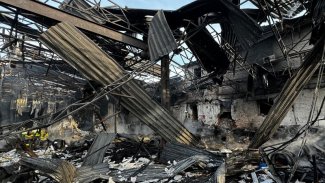A new front in Kharkiv oblast. Day 810 of the war


On 10 May, Russian troops crossed the border into Kharkiv oblast, striking in three directions north and north-east of Kharkiv. Within four days, they had pushed the defenders to 5–6 km from the border and combined their own forces, creating a new section of front up to about 60 km wide. Depending on sources, the invaders have taken control of between nine and 13 villages as well as part of Vovchansk, a major road node north-east of Kharkiv. In addition to the ongoing battle for Vovchansk, the Russians are also trying to break through Ukrainian defences north of the regional capital in the area of the village of Lyptsi.
The invaders used a relatively small force for the attack: on the first day of operations, it numbered around 2000 soldiers (between four to five battalions), although this number rose to several thousand over the following days. Currently the core of the Russian grouping, about five battalions in strength, is engaged in the Vovchansk area. Reports from the head of the National Security and Defence Council of Ukraine Oleksandr Lytvynenko that the invaders have engaged 30,000 troops in combat, while the entire grouping allegedly numbers 50,000, should be treated as an element of information warfare. The invading forces are relatively sparse, as underlined by Kyiv’s assurances that there is currently no threat of them striking at Kharkiv city. The predominant view in Ukrainian and Western discussions is that the Russian aim is to create a buffer zone on the Ukrainian side of the border to reduce opportunities for shelling Russian territory (mainly Belgorod), as Moscow has been suggesting for several months.
The Russian attack has demonstrated the weakness of the Ukrainian defences. Despite having several months to make preparations to repel a potential Russian offensive, the lines of fortifications were not properly organised, and there have been accusations in the Ukrainian media that some of the funds allocated for this purpose were embezzled. The towns along the border itself were already in a de facto ‘grey zone’, and were most likely not defended at all. The unpreparedness of the units responsible for defending this section of the border is a separate issue. It is almost certainly a consequence of the general exhaustion – in terms of personnel, ammunition and equipment – in which the Ukrainian army finds itself. On 11 May, the commander of the Operational-Tactical Group of Troops “Kharkiv” was replaced: General Yuriy Halushkin, who had been appointed only two months earlier, was replaced by General Mykhailo Drapatyi (who remains Deputy Chief of the General Staff of the Ukrainian Armed Forces). The slowdown of the Russian advance required the Ukrainian command to draw down its reserves (and also, according to some sources, experienced and better-prepared subunits from other sections of the front).
The Russian capture of border areas in the north-eastern part of Kharkiv oblast has enabled them to take a number of further actions. Opening up a new section of the front has forced the defenders to engage their reserves and disperse their efforts even further; the invaders may take advantage of this in the coming weeks to intensify their activity along other axes. The possible seizure of Vovchansk would pave the way for a further strike in the southern direction; if Moscow decides on a new offensive, Russian forces would have the option of outflanking of Kharkiv from the east or launching a renewed attempt to strike from the north into the Ukrainian-controlled part of the Donbas (similar efforts by the invaders in the summer of 2022 failed). In the nearer term, on the other hand, it could also threaten to cut off the Ukrainian grouping in the region of Kupyansk from its hinterland.
In an interview with the New York Times on 14 May, the head of Ukrainian military intelligence Kyrylo Budanov predicted that the attacks in Kharkiv oblast would continue for the next few days, after which Russian forces would launch a strike towards Sumy. At present, the Ukrainian army’s task is to stabilise the defence line and then start pushing the enemy back into its territory. He added that the Russian attacks in the north-east are aimed at pulling back the already small Ukrainian reserves from other sections of the front.
Russian forces made further advances north and west of Orikhiv and west of Avdiivka, where they seized most of the village of Umanske and the centre of the village of Netailove. This forced the defenders to form another line of defence along the Karlovsky Reservoir and the Vovcha river. In Krasnohorivka, the invading forces attacking from the south and north-east have been combined, resulting in the eastern part of the town coming under Russian control. To the south of Velyka Novosilka, the invading troops were reinforced in part of Urozhaine and entered the neighbouring town of Staromayorske, depriving the defenders of another of their gains from last summer’s offensive. They also expanded the area under their control south of Chasiv Yar on the eastern side of the Donets-Donbas canal.

On 8 May, the Russians launched another massive missile attack on Ukraine’s energy infrastructure. They again attacked three thermal power plants belonging to DTEK: Burshtyn in Ivano-Frankivsk oblast, Ladyzhyn in Vinnytsia oblast and Dobrotvir in Lviv oblast, as well as two Ukrhydroenergo hydroelectric power plants: Dnieper in Zaporizhzhia city and Kremenchuk. Power infrastructure facilities in the Kyiv, Kirovohrad and Poltava oblasts were hit; the operators confirmed that the damage led to the facilities being taken out of service. According to unofficial reports, only one of Ukraine’s large thermal power plants, at Kryvyi Rih, is working. In Lviv oblast, a Naftohaz facility near the town of Stryi was once again attacked.
Kharkiv remains the main target of Russian attacks at the rear of the frontline. The city has been hit daily by missiles, kamikaze drones or guided aerial bombs. On two occasions (11 and 12 May), the city of Sumy was targeted by rocket attacks. On 8 May, the railway infrastructure (including the railway station) in Kherson was damaged; the next day strikes were reported on the airport in Mykolaiv, and most likely the military infrastructure in the Chernihiv and Odesa oblasts. In total, from the evening of 7 May until the morning of 14 May, the invaders used 87 missiles (including 55 in an attack on energy infrastructure on 8 May), of which the defenders claimed to have shot down 42 (including 39 on 8 May); 61 Shaheds were also fired in that period, 57 of which were destroyed.

On 7 May, the Security Service of Ukraine announced the detention of two colonels of the State Protection Directorate (SPD) who were suspected of preparing an assassination attempt on President Volodymyr Zelensky and other senior government officials. They were charged with treason and aiding & abetting the preparation of a terrorist act on behalf of the Federal Security Service. One of the tasks of the FSB’s intelligence network was to recruit persons serving in the protection of the president who could carry out an assassination attempt on him. According to the SBU, the elimination of the heads of the SBU and military intelligence was also planned. The detainees were allegedly paid a retainer of $3000 a month over a long period, and were promised a bonus of $50,000 for carrying out the assassination. After the case came to light, President Zelensky dismissed the SPD’s head Serhiy Rud from his post.
On 13 May, the SBU revealed that two men planning to carry out a terrorist attack were detained in Kyiv on 9 May. They had intended to plant explosive devices (a total of 15 charges, disguised as items of food) in three shopping centres and in a car parked near a popular cafe. According to Ukrainian counterintelligence, the attack was ordered by one Yuriy Sizov, an officer of the Russian special services.

Ukrainian forces continued to attack fuel infrastructure facilities in the occupied territories and deep inside Russia. On the evening of 7 May they hit a fuel depot in Luhansk, which (most likely as a result of ATACMS missile strikes) caught fire. Two days later, kamikaze drones targeted a Gazprom-owned refinery in Salavat, Bashkortostan (1300 km from the line of contact), where facilities were damaged and a fire broke out, and a fuel base in Yurivka, Krasnodar krai, which was most likely not hit. The attack on the Kaluga refinery on 10 May also failed to have any significant effect. However, a strike on a fuel depot in Rovenky in Luhansk oblast was successful. On 12 May, a kamikaze drone caused a fire at a refinery site in Volgograd, but no major damage was reported; a day later another drone hit a power substation in Lipetsk oblast.
After Russian troops crossed the Ukrainian border into Kharkiv oblast on 11 May, the city’s defenders intensified their shelling of Belgorod, the invaders’ main logistical base. A day later, falling debris – according to the Russian side, from a downed Ukrainian Tochka-U missile – allegedly contributed to the destruction of part of a residential building in Belgorod, leaving 15 people dead and 31 injured.
On 13 May there was another Ukrainian strike on occupied Crimea using kamikaze drones and Storm Shadow cruise missiles. According to some sources, there was a strike on the facilities of the ‘secret’ base of the 3rd radio-technical regiment of the Russian Aerospace Forces on Mount Ai-Petri (the regimental commander, among others, was killed), but this report has not been confirmed.

On 8 May, the Ukrainian parliament passed a law allowing certain categories of prisoners to join the army as part of the ongoing mobilisation. Only inmates for minor offences will be allowed to leave prisons. The decision on the conditional release of a given convict for contractual military service will be made by the court. Commanders of military units will be entrusted with the administrative supervision of those released early. The duration of the contract is to be between six and 12 months, with a penalty of five to 10 years’ imprisonment for deserting the military unit. Two days later, justice minister Denys Maliuska estimated that up to 20,000 prisoners could be mobilised in this way.
On 9 May, the Slovak border service reported that from the beginning of the year until the end of April, they had detained and released 338 Ukrainians who had crossed the border illegally. The statement specified that these persons had been granted residence permits in Slovakia, and that there has not been a single case of readmission of migrants from that country to Ukraine since the beginning of the war. On 10 May, the Romanian border service stated that between February 2022 and May this year, some 11,000 Ukrainians aged between 18 and 60 had crossed the border illegally in order to avoid mobilisation. From January to April 2024, 1218 cases of illegal crossing of the state border with Romania were recorded, and the trend is reportedly rising. As in Slovakia, the Romanian governments do issue residence permits to Ukrainians.
On 10 May General Oleksandr Pavliuk, the commander of the Land Forces of the Ukrainian Armed Forces, announced the formation of 10 new brigades in preparation for repelling an expected Russian offensive. Some of them will be assigned to protect Kyiv. Pavliuk pointed out that the main problem with forming new units is not a lack of men, but rather of equipment, especially the artillery and armoured weapons which Ukraine expects to receive from the West. On 18 May, a new mobilisation law comes into force; its primary task will be to replenish manpower in already existing brigades. Together with the units formed during the hostilities (mainly for territorial defence), the Ukrainian army has 80 brigades, but a large number of them have lost substantial numbers of men during the course of the fighting so far.
On 10 May, the Ukrainian government allocated 750 million hryvnias (more than $18 million) from the budget reserve to the Main Intelligence Directorate of the Ministry of Defence. The money is to cover activities related to strengthening the state’s defence capabilities. In the first quarter of this year, spending on the security and defence sector amounted to 408.2 billion hryvnias (more than $10 billion).

On 10 May, the US Department of Defense announced a new $400-million military support package. Under the Presidential Drawdown Authority (PDA) mechanism, the following will be transferred from US Army depots: Bradley infantry fighting vehicles and M113 tracked transporters, HIMARS launchers with missiles, surface-to-air missiles for Patriot, NASAMS and Stinger systems, equipment for the integration of Western anti-aircraft missiles and radar stations with post-Soviet systems (FrankenSAM), 155-mm and 105-mm artillery ammunition, Javelin and TOW anti-tank guided missiles and AT4 grenade launchers, HARM anti-radiation missiles, precision aerial bombs and MRAP armoured cars. The amount of equipment being handed over has not been disclosed, although expert estimates suggest that the package includes at least 100 Bradleys and an equal number of M113s. This would be the largest single delivery of armoured combat vehicles since spring 2023, largely covering the losses suffered by the Ukrainian army. On 10 May, the State Department agreed to Germany’s sale and subsequent transfer of three HIMARS launchers to Ukraine, which the German defence minister Boris Pistorius had announced the day before. In turn, the Defence Industry Europe website reported that a new Australian support package worth $100 million would include RBS 70 NG man-portable air defence systems.
On 13 May, the daily El País revealed that the previously announced Spanish military aid package, the most important part of which will be 10 refurbished Leopard 2A4 tanks, is to be ready by 30 June. At a later date, Ukraine is to receive nine more vehicles of this type from Spain. Madrid will thus come out on top in terms of the number of Leopard 2 tanks delivered (including those handed over in 2023, there will be 29 in total), ahead of Germany and Poland. In addition to the Leopards, the new Spanish support package will include infantry fighting vehicles and artillery ammunition & anti-tank weapons.





